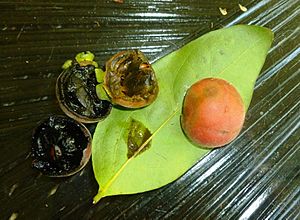Garcinia warrenii facts for kids
Quick facts for kids Garcinia warrenii |
|
|---|---|
 |
|
| Native mangosteen fruit on tree | |
| Scientific classification | |
| Genus: |
Garcinia
|
| Species: |
warrenii
|
Garcinia warrenii, also known as the native mangosteen or Warren's mangosteen, is a fruit tree. It can grow up to 15 meters (about 50 feet) tall. This tree belongs to the mangosteen family, called Clusiaceae. You can find it in the warm, wet rainforests of northern Australia and New Guinea.
The Garcinia group of trees has about 200 different kinds. Most of them grow in tropical parts of Asia and Africa. Garcinia warrenii is special because it comes from New Guinea, the Torres Strait Islands, and northeastern Queensland in Australia. There is also a small group of these trees on Melville Island in the Northern Territory.
You can find Garcinia warrenii growing in different types of rainforests. This includes regular rainforests, coastal rainforests (called littoral rainforests), and forests along rivers (called riparian forests). They grow from sea level up to about 780 meters high.
Contents
What is it Used For?
There are five types of native Garcinia trees in the forests of north Queensland. But Garcinia warrenii is the only one that has fruit you can eat! Even though the fruits are safe to eat, people don't usually look for them to eat very often.
How to Identify Native Mangosteen
Garcinia warrenii is a close relative of the well-known mangosteen fruit (Garcinia mangostana). This tree is often bushy and can grow straight up to 15 meters tall. It can be hard to spot among other trees in the forest.
Leaves and Flowers
This tree has pretty white flowers that smell nice. Its leaves are thick and feel like leather. You might often see them with mold or small plant growths called lichens on them. If you break a leaf stalk (called a petiole) or a small twig, a sticky yellow liquid comes out. The leaves are usually about 10 to 16 centimeters long and 4 to 8 centimeters wide.
Fruits and Animals
The fruit of the native mangosteen is purple and tastes sweet. Fruit bats, which are also known as Pteropus, love to eat these fruits.



